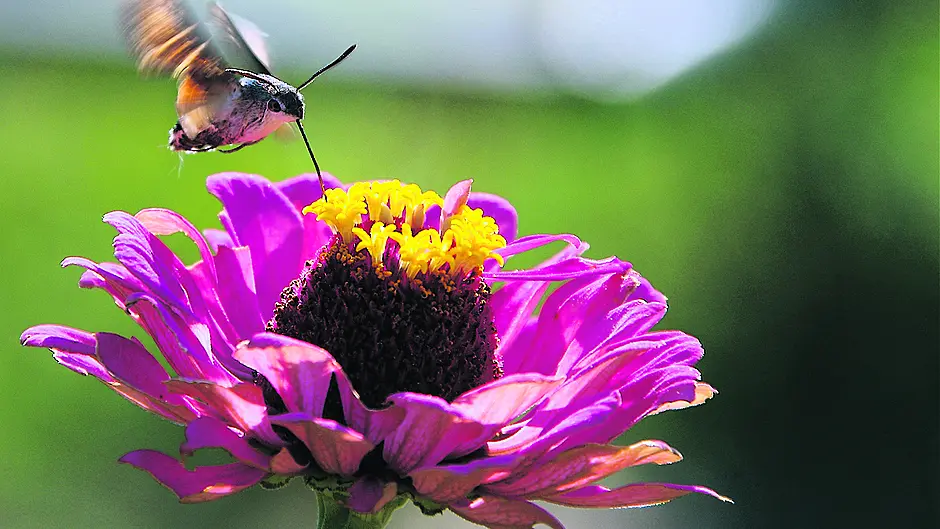A DISTINCTIVE high-pitched buzzing sound caught my attention while I was weeding in the garden the other day and I followed it to find – oh joy – a hummingbird hawk moth feeding on the Valerian.
A sighting of a hummingbird hawk moth is always a thrill as it’s quite an extraordinary- looking creature that somehow seems too exotic to be seen in an Irish garden.
This year has been a good year for hummingbird hawk moths, with the prevailing easterly winds enabling their migration to our shores, and I’ve heard reports of several sightings in this area. And the amazing migrations that these frail looking creatures undertake adds further to their mystique.
Exotic
A hummingbird hawk moth is a truly spectacular sight. Like the hummingbird, it hovers in front of a flower to feed, using its long proboscis to reach the nectar in the same way as the bird uses its tongue.
When hovering to feed in this way, its wings beat so fast that they appear as a hazy blur, and they emit a high pitch humming sound that is audible at close range. Not surprisingly, many people who have not seen one before take it to be a hummingbird. The resemblance between the two is remarkably close — the moth’s long black and white scales at the end of its abdomen are spread out like a bird’s tail and even its eyes are bird-like.
And, because the hummingbird hawk moth is a day-flying moth, we are more likely to see it than its night-flying relatives.
The hummingbird hawk moth is resident in southern Europe, particularly around the Mediterranean. In the spring, many hummingbird hawk moths travel northwards throughout Europe and usually start to arrive in Ireland in the early summer months.
Some go even further north and this exotic-looking moth has even been recorded in Iceland.The female hummingbird hawk moths lay their eggs on arrival here and their green/brown caterpillars feed during July and August. When full-grown, they construct cocoons and the moths emerge from these after about three weeks.
Moth ‘memory’
It’s hard to equate the adult form of these creatures with their caterpillar counterparts. While the hummingbird hawk moth is a glorious and quite magical creature, its caterpillar stage is a nondescript green creature with brown-ish spots. However, its relative, the elephant hawk moth, is exceptional as a caterpillar, with fake ‘eyes’ and the ability to form a ‘head’ when threatened.
However different the moth and caterpillar, they are the same animal throughout all the metamorphic stages as the ‘scaffolding’ of the moth is contained within the caterpillar. Cells called imaginal disc cells are present in a caterpillar from when it is the size of a grain of rice and these persist into the adult stage despite the dramatic metamorphosis it undergoes.
Indeed studies have shown that adult moths can ‘remember’ things they learnt as caterpillars, so neurons formed in that stage persist into the adult stage to carry these memories. Some of the proteins from the caterpillar’s body are dissolved and remodelled but some elements simply change shape for the adult purposes.
Why these creatures go through the three stages of development – from caterpillar to pupal stage to adult moth – seems overly complex and hard to explain in evolutionary terms. But it is a highly successful strategy overall.
The vast majority of insects on this plant undergo some form of metamorphosis and this type of development is over 280 million years old. These insects are the most successful animals on earth so clearly there is a benefit involved in this seemingly overcomplicated process.
Each stage of development is highly specialised for its specific function. The caterpillar to eat, eat, eat and grow. The pupal stage to hide and remains safe during this vulnerable stage. And the adult moth/caterpillar to breed and move around by wing to spread its genes.
This division of labour means that there is no compromise involved and each stage can devote everything towards its own specialisation. A clever but seemingly cumbersome strategy that is highly effective.
Do keep an eye and ear out this summer for these glorious creatures as it really is a thrill to experience one on the wing.










